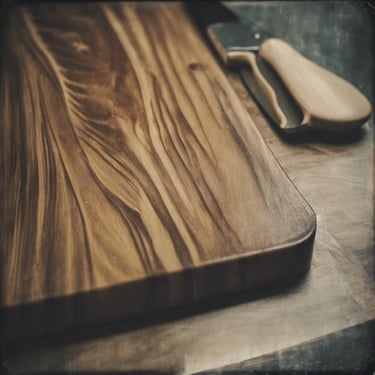The Ultimate Guide to Caring for Teak Tableware: Bowls, Spoons, and Cutting Boards
1/31/20256 min read


Introduction to Teak Tableware
Teak tableware has gained considerable popularity in kitchens and dining settings due to its superior quality and aesthetic appeal. Crafted from the richly textured teak wood, this tableware not only serves functional purposes but also enhances the overall dining experience. The natural beauty of teak, characterized by its golden-brown hue and unique grain patterns, provides an elegant touch to any meal, making it a favorite choice for both everyday use and special occasions.
One of the standout features of teak wood is its remarkable durability. Unlike many other types of wood, teak is inherently resilient, which allows it to withstand the rigors of daily use without succumbing to wear and tear. This strength is attributed to the natural oils present in teak, which also lend the wood exceptional resistance to moisture and humidity. This makes teak tableware an ideal option for diverse settings, from outdoor picnics to well-appointed dinner tables.
In addition to its durability, teak possesses natural anti-fungal and anti-bacterial properties, making it a safer option for food contact. The inherent oils protect the wood from harmful microorganisms, ensuring that it remains safe and hygienic for serving food. Moreover, teak does not absorb odors or flavors, allowing for a purer dining experience. Families and chefs alike value these attributes, contributing to the growing trend of teak tableware in contemporary kitchens.
As teak continues to become a staple in tableware choices, it is crucial to recognize the importance of proper care and maintenance. By understanding the unique characteristics of this wood, users can ensure the longevity and beauty of their teak bowls, spoons, and cutting boards. This foundational knowledge sets the stage for effectively protecting and preserving these exquisite culinary tools.
Benefits of Using Teak Tableware
Teak tableware, including bowls, spoons, and cutting boards, offers a multitude of advantages, making it a preferred choice in many kitchens and dining spaces. Some of the primary benefits include:
Exceptional Durability: Teak wood is known for its dense composition, which makes it highly resistant to wear and tear, outperforming many other types of wood. This robustness ensures that teak tableware can withstand daily use without easily showing signs of damage.
Aesthetic Appeal: The rich, golden-brown hue of teak, coupled with its fine grain patterns, adds elegance and sophistication to any table setting. Whether in casual or formal environments, teak products elevate the visual appeal of dining experiences.
Resistance to Warping and Cracking: Teak’s natural properties make it less susceptible to warping and cracking, especially in environments with fluctuating moisture levels. This ensures that your teak tableware remains in excellent condition over time.
Hygienic Properties: Teak possesses inherent anti-fungal and anti-bacterial properties due to its high oil content, which reduces the likelihood of mold and bacteria growth. This is essential for maintaining hygiene in food preparation and serving.
Sustainability: Opting for sustainably sourced teak products supports environmental sustainability. Teak grows in tropical regions and, when harvested responsibly, contributes to forest conservation efforts.
In conclusion, the durability, aesthetic charm, resistance to environmental factors, and sustainable nature of teak tableware make it an excellent investment for those seeking both functionality and style in their kitchen and dining areas.
What to Avoid When Caring for Teak Tableware
To maintain the beauty and longevity of teak tableware, it is essential to be aware of certain practices to avoid. Here are key points to consider:
Harsh Cleaning Products:
Avoid using general-purpose cleaners that contain chemical compounds.
Opt for mild soap and water .
Soaking in Water:
Do not soak teak items in water for prolonged periods, as it can cause swelling and warping.
Avoid using dishwashers for cleaning teak.
Direct Sunlight and Heat:
Protect teak tableware from direct sunlight, which can fade its color.
Keep it away from high heat sources like stoves and ovens.
Overcrowding in Storage:
Avoid stacking teak items too closely together to prevent friction and scratches.
Organize items to allow ample space between each piece.
By avoiding these common pitfalls, you can significantly extend the life of your teak tableware, ensuring that it remains a centerpiece in your dining experience for years to come.
How to Clean Teak Tableware Safely
Cleaning teak tableware requires careful consideration to ensure the preservation of the wood's natural beauty and durability. Here are the steps to clean teak safely:
Gather Supplies:
Mild soap
Water
Soft sponge or cloth
Towel
Initial Rinse:
Rinse the teak item under water to remove food residues.
Prepare Soapy Water:
Mix a few drops of mild soap in a basin filled with water, ensuring the soap is dissolved.
Wipe Down:
Dip the sponge or cloth into the soapy water, wring it out to prevent excess moisture, and gently wipe the surface of the teak tableware.
Stubborn Stains:
For stubborn stains, use a soft-bristle brush to delicately scrub the affected area without scratching the wood.
Final Rinse:
Rinse the item with clean water to eliminate soap residue, being cautious not to use excessive moisture.
Drying:
Dry the item immediately with a soft towel to avoid prolonged moisture exposure.
Odor Removal:
For absorbed odors, create a paste with baking soda and water, apply it to the affected areas, let it sit for 15-20 minutes, then rinse thoroughly.
Stain Restoration:
For visible stains, mix white vinegar and olive oil, apply with a soft cloth, and buff in circular motions until the stain diminishes.
Proper care will keep your teak tableware looking beautiful and ensure its longevity, making your dining experience even more enjoyable.
Oiling and Conditioning Teak Tableware
Teak tableware, known for its durability and natural beauty, requires regular maintenance to preserve its aesthetic appeal and functionality. One of the most vital aspects of caring for teak items is the process of oiling and conditioning. Here’s how to do it effectively:
Frequency of Oiling:
Oil your teak tableware every three to six months, depending on usage and exposure to moisture.
Choose Quality Oil:
Use teak oil or food-grade mineral oil. Teak oil penetrates deeply and enhances protection, while mineral oil is safe for food contact.
Application Method:
Start by cleaning the surface with mild soap and water.
Allow the item to dry thoroughly before applying oil.
Using a clean, lint-free cloth, apply a generous amount of oil evenly, working in the direction of the wood grain.
Soaking Time:
Let the oil soak in for at least 20 minutes, then wipe away any excess oil with a clean cloth. This enhances the appearance and creates a protective barrier.
Storage Tips for Teak Tableware
Proper storage of teak tableware is essential to ensure its longevity and maintain its exquisite appearance. Consider the following tips for effective storage:
Cool, Dry Place:
Keep teak items in a climate-controlled environment to avoid warping or cracking caused by excessive heat and humidity.
Use Protective Cloths:
Wrap or cover your teak items with breathable fabric, such as cotton or linen, to protect against dust and scratches.
Avoid Plastic Covers:
Do not use plastic coverings, as they can trap moisture and promote deterioration.
Organized Storage:
Avoid overcrowding storage spaces to prevent friction and scratches. Arrange items to allow ample space between each piece.
By adhering to these storage guidelines, you can significantly extend the life of your teak tableware. Proper care and attention will allow you to enjoy the functional elegance of these items for many years to come.
Conclusion: Embracing Teak in Your Kitchen
In the realm of kitchenware, teak tableware such as bowls, spoons, and cutting boards stands out for its unique blend of functionality, durability, and aesthetic appeal. The qualities that make teak so desirable are both its natural beauty and its resilience against the rigors of daily use. Teak wood possesses high oil content, which enhances its visual allure and provides natural resistance to moisture and decay. Consequently, investing in teak products means acquiring kitchenware that can withstand the test of time when maintained properly.
The significance of proper care and maintenance for teak tableware cannot be overstated. Simple practices such as washing with mild soap and water, avoiding the dishwasher, and applying mineral oil can greatly extend the life of your teak items. These measures ensure that the wood retains its luster and does not succumb to damage from excessive moisture or harsh chemicals. By following these guidelines, owners can enjoy their exquisite teak utensils and boards for many years, keeping their kitchens both stylish and functional.
Beyond practicality, teak tableware is also a sustainable choice. Sourced from responsibly managed forests, it embodies an environmentally conscious decision for consumers who wish to reduce their ecological footprint. Embracing teak in your kitchen means not only embracing elegance and durability but also supporting sustainable practices that protect our planet. The unique grains and rich hues of teak enhance the presentation of culinary creations, making meals not just nutritious but also visually appealing.
In conclusion, the decision to incorporate teak tableware into your kitchen offers a delightful combination of aesthetic pleasure, functionality, and ecological responsibility. By valuing both the beauty and practicality of these items, you ensure that your kitchen evolves into a space that reflects your commitment to quality, sustainability, and style. Thus, investing in teak products is an investment in a harmonious kitchen environment that celebrates both nature and culinary excellence.


Support
Signup for Newsletter
© 2024. All rights reserved till now.
